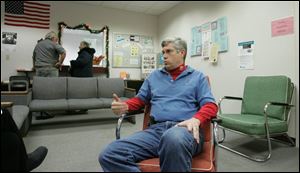
Idea of merging health agencies draws skepticism
12/25/2005
Dr. Greg Arnette, Hancock County's health commissioner, says the cost of a merger would outweigh the benefits.
FINDLAY - Since Greg Arnette became Hancock County's health commissioner in 1988, talk of a merger between the county and Findlay city health departments has come up at least a half dozen times.
It's never gone far, though, and he's doubtful that Mayor Tony Iriti's latest suggestion to look at combining the agencies into a one-county general health district will either. It's not that it doesn't sound like a good idea, Dr. Arnette said.
"I think there is some validity to the idea. If you're all in one place, it obviously is easier for the general public to go to one place for all your services," he said. "Philosophically, I'm not opposed to the idea of combining, but I think it's going to cost far more than any benefits that would be gained."
The mayor, who proposed opening talks about a possible merger in a recent letter to the city and county health departments, insists there would have to be cost savings in such a move, but neither Dr. Arnette nor city Health Commissioner Stephen Mills is convinced.
Both are familiar with counties that have merged health departments only to have their staffs and budgets grow. And in a county that is less than friendly toward higher taxes, they know that would not be popular with taxpayers.
"The bottom line is, are we taking care of the public health in the community, and I think we are," Dr. Mills said. "I'm not sure we could do it better combined."
Despite their misgivings, both the city and county health boards have agreed to form study committees to meet with the mayor and each other and take another look at the pros and cons of merging.
Both camps agree that if merging would save taxpayers' money, they would be in favor of it.
"They do immunizations. We do immunizations. They do vital statistics. We do vital statistics. We have plumbing inspectors. They have septic-tank folks," Mr. Iriti said. "It just makes so much sense to look at it from the standpoint of how can we make it less expensive to provide the same services to all of our folks?"
In northwest Ohio, only Hancock County and Huron County maintain city and county health departments. Statewide, there are 48 city health departments, including 11 in the three most populous counties: six in Hamilton County, three in Cuyahoga County, and two in Franklin County.
The Toledo and Lucas County health departments merged in 2000 - a move that resulted in more efficient management, an experienced staff, and the ability "to speak with one voice" on issues ranging from rabies control to food-service inspections, said Larry Vasko, deputy health commissioner.
Bill Snouffer, administrator for the local health department unit of the Ohio Department of Health, said the number of city health departments has dropped in the past two decades as public-health issues become more complex. "Bioterrorism, [disaster] preparedness-type activities, some of the different diseases that have been taking place such as West Nile virus make it very complex for the small departments that may only have three or four people," Mr. Snouffer said.
Counties with combined health departments also find that they are more competitive for state and federal grants because they serve a larger population base, Mr. Snouffer said.
Dr. Arnette said neither argument would be true in Hancock County, where the city and county frequently apply for grants jointly anyway. The two departments also share resources whenever they can, including an employee who works half time for the city on substance-abuse prevention and half time for the county doing disaster planning, he said. "The Findlay city and Hancock County health departments work well together. All of our programs are in sync," Dr. Arnette said.
When the city enacted public smoking rules, the county adopted the same ones. When the city adopted penalties for tobacco vendors who sell to minors, the county followed suit. They have the same rules for governing tattoo parlors.
"If we have meetings out of town, we even carpool together," he said. "We really have an excellent working relationship."
With a $600,000 budget, Hancock County has eight full-time and two part-time employees who work out of a county office building in downtown Findlay that also houses the elections board, veterans services, and the adult probation department.
The Findlay Health Department has 11 full-time and two part-time employees stationed in a small office building about eight blocks away. Its budget for 2005 was $972,000, although it expected to spend only $914,000 by the end of the year.
Merging the two departments would mean finding or building larger offices, but it's unclear whether a merged department could operate with fewer employees or a smaller budget.
Dr. Arnette doesn't think so. The health department just couldn't be any leaner, he said.
"We are two health departments serving two similar-sized populations on extremely bare-bones budgets with small staffs that I think do an excellent job," Dr. Arnette said.
Dr. Mills agreed that a merger could cause expenses to rise, but he wants to investigate the possibilities.
"I want what's best for the community," he said. "If it looks like we can do a better job as a collaboration, then we should do it, especially if we're going to break even or save money."
Contact Jennifer Feehan at: jfeehan@theblade.com or 419-353-5972.